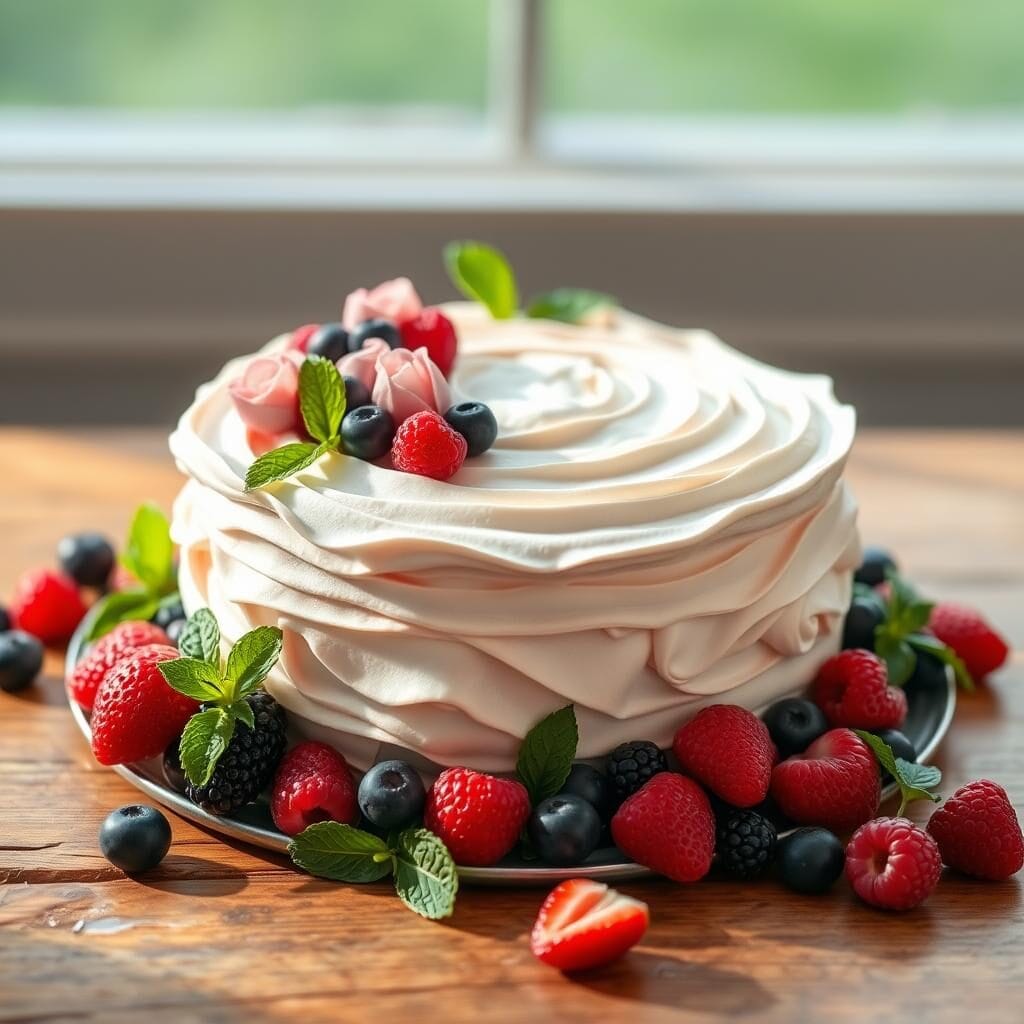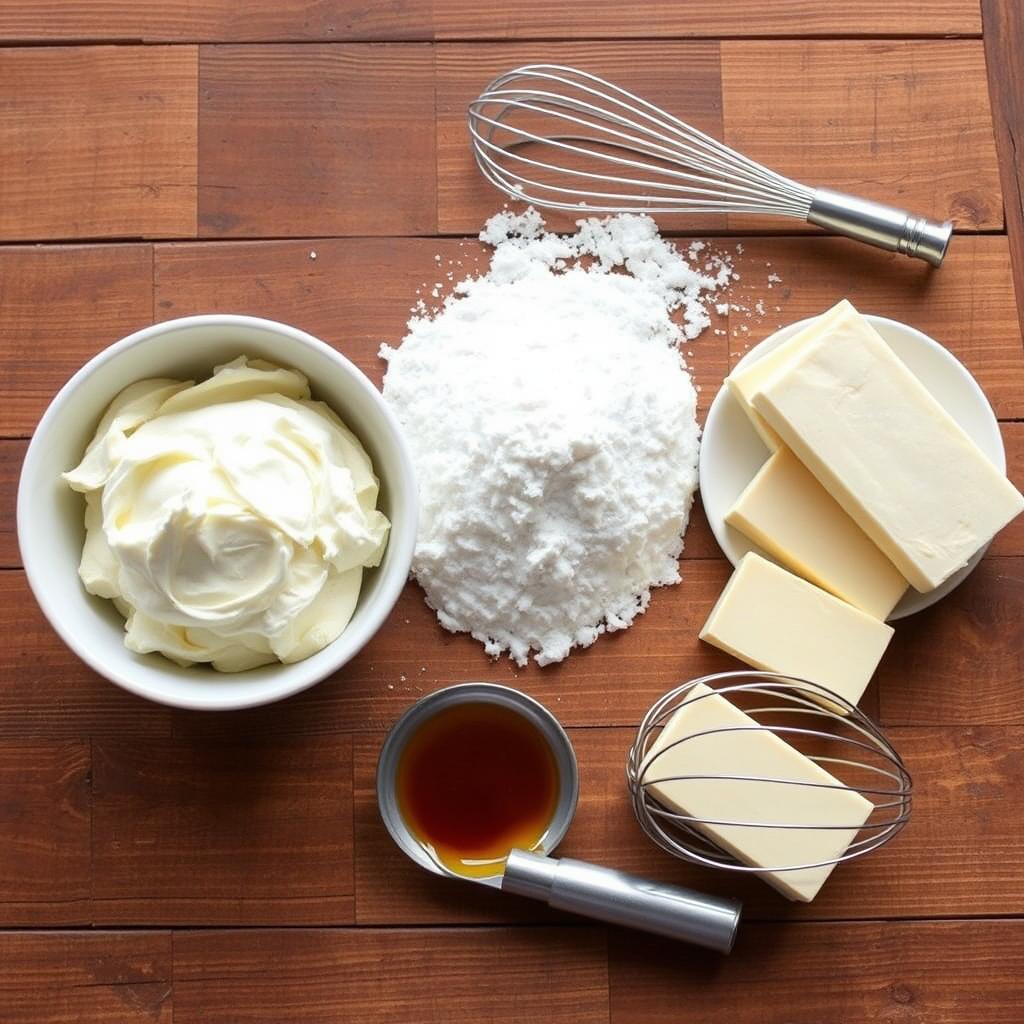What Are the Pros and Cons of Cream Cheese Frosting? I love baking and always choose cream cheese frosting. Its smooth, tangy flavor makes any cake or cupcake stand out. However, like any option, it has its advantages and drawbacks. Let’s explore the good and bad of cream cheese frosting for your next baking project.

Understanding Cream Cheese Frosting Basics
Essential Ingredients for Perfect Cream Cheese Frosting
To make the best cream cheese frosting, you need a few key things: cream cheese, butter, powdered sugar, and vanilla extract. The right mix of these can change the frosting’s taste and feel.
The Science Behind Cream Cheese Frosting
Cream cheese is special because it’s fatty and tangy. When you mix it with butter and sugar, you get a frosting that’s creamy and delicious.
Historical Origins and Modern Applications
Cream cheese frosting has been around since the early 1900s. It was first used on carrot and red velvet cakes. Now, it’s a favorite for all sorts of baked goods, including cheesecakes.
The Rich and Tangy Flavor Profile
The mix of cream cheese and butter gives frosting a rich, tangy taste. It’s creamy and less sweet than regular buttercream, which many people enjoy.
Advantages of Using Cream Cheese Frosting
Versatility in Cake Decorating
Cream cheese frosting is great for decorating. You can pipe, swirl, or smooth it to make beautiful designs.
Unique Taste Combinations
The tangy frosting goes well with many cake flavors. This lets bakers create unique and tasty desserts.
Texture Benefits
The frosting’s creamy texture makes baked goods feel luxurious. It adds to the overall enjoyment of eating them.
What Are the Pros and Cons of Cream Cheese Frosting?
Like any choice, cream cheese frosting has its good and bad sides. Knowing these can help you decide if it’s right for your baking.
Temperature Sensitivity and Storage Challenges
Proper Storage Methods
Cream cheese frosting needs careful storage because it’s sensitive to temperature. Keeping it refrigerated is key to keeping it fresh and safe.
Shelf Life Considerations
Because cream cheese is perishable, frosting made with it doesn’t last as long as buttercream. This is something to think about when planning your baking.
Travel and Transportation Issues
Transporting baked goods with cream cheese frosting can be tricky. The frosting can soften or melt if it gets too warm.
Cream Cheese Frosting vs. Traditional Buttercream
Cream cheese frosting and buttercream are both popular, but they’re different. They have different tastes, textures, and uses in baking.
Nutritional Aspects and Dietary Considerations
Caloric Content and Fat Analysis
Cream cheese frosting has more calories and fat than buttercream. This is important for those watching their diet.
Dietary Restrictions and Alternatives
For those on special diets, like low-fat or dairy-free, there are other frosting options. These might be better choices.
Common Problems and Troubleshooting Tips
Working with cream cheese frosting can have its challenges. Knowing how to fix common problems can help you get great results.
Creative Applications and Recipe Variations
Seasonal Flavor Adaptations
You can change cream cheese frosting to match the seasons. This lets bakers create desserts that fit the current tastes.
International Recipe Inspirations
Cream cheese frosting can be used in many international recipes. This opens up a world of flavors for bakers to explore.
Professional Baking Tips for Perfect Results
Getting perfect cream cheese frosting takes skill and attention to detail. Following tips from experienced bakers can help you improve your baking.
Time Investment and Preparation Techniques
Making great cream cheese frosting takes time and effort. Knowing how to prepare and manage your time can help you succeed.
Conclusion
Cream cheese frosting is a favorite for many. It adds a unique taste and texture to desserts. Understanding its pros and cons can help bakers make the most of it.
Key Takeaways
- Cream cheese frosting has a rich, tangy flavor that pairs well with many cakes.
- Its creamy texture makes baked goods more enjoyable to eat.
- It needs careful storage because of its temperature sensitivity.
- It’s higher in calories and fat than buttercream, which is important for diet-conscious bakers.
- Mastering preparation techniques and understanding the time needed can lead to professional results.
Understanding Cream Cheese Frosting Basics
Cream cheese frosting is a favorite topping for many. It’s loved by bakers and dessert fans everywhere. Knowing the ingredients and how it’s made is key to making it perfect. Whether for a special event or just because, mastering cream cheese frosting can take your baking to the next level.
Essential Ingredients for Perfect Cream Cheese Frosting
The base of great cream cheese frosting is its ingredients. You need top-notch cream cheese, unsalted butter, powdered sugar, and a bit of vanilla extract. Each part is important for the right taste and texture. Cream cheese frosting ingredients must be mixed just right to get the perfect mix of tangy, sweet, and rich.
The Science Behind Cream Cheese Frosting
The science of cream cheese frosting is all about the mix of ingredients. Cream cheese gives it a smooth, creamy feel. Butter adds to the creaminess. Powdered sugar sweetens it and keeps it stable. Vanilla extract adds flavor, making it taste amazing.
Historical Origins and Modern Applications
Cream cheese frosting has a long history, starting in the early 20th century. It became popular in America and has since become a favorite everywhere. Today, cream cheese frosting recipes are used in many desserts, from classic treats to new ones. It shows how versatile and loved it is.

The Rich and Tangy Flavor Profile
Cream cheese frosting is known for its unique taste. It combines cream cheese, butter, and sugar for a rich, tangy, and creamy flavor. This mix of sweetness and tanginess makes it a favorite among bakers and dessert lovers.
The secret to its great taste is high-quality cream cheese. The tartness of the cream cheese and the sweetness of the sugar create a perfect balance. This flavor enhances many cakes, cupcakes, and baked goods, making them unforgettable.
| Flavor Characteristics | Intensity Level |
|---|---|
| Sweetness | Moderate |
| Tanginess | Moderate to High |
| Creaminess | High |
| Richness | High |
The cream cheese frosting flavor is rich and tangy, making it perfect for many desserts. It’s great on carrot cake, cupcakes, or cheesecake. The unique taste of cream cheese frosting always impresses your guests.

“The flavor of cream cheese frosting is like a delightful dance between sweet and savory, creating a symphony of taste that elevates every dessert it graces.”
Advantages of Using Cream Cheese Frosting
Cream cheese frosting is a favorite among bakers for cake decorating. It’s versatile and can be used in many creative ways. The cream cheese frosting texture is perfect for different decorating techniques, making your cake look great.
But cream cheese frosting is more than just pretty. It tastes amazing too. Its tangy flavor goes well with many cake types, like vanilla or chocolate. This mix of cream cheese, butter, and sugar is a hit with everyone.
Versatility in Cake Decorating
Cream cheese frosting lets bakers get creative. It’s smooth and creamy, great for detailed designs. Whether you’re making a fancy wedding cake or a fun birthday cake, it’s the perfect choice.
Unique Taste Combinations
The cream cheese frosting benefits go beyond looks. Its unique taste pairs well with many cakes, like lemon or red velvet. The tangy cream cheese balances the cake’s sweetness, making every bite a joy.
Texture Benefits
The cream cheese frosting texture is a big plus. It’s creamy and velvety, unlike regular buttercream. This texture makes the cake taste better and stay moist, ensuring a delicious treat.
What Are the Pros and Cons of Cream Cheese Frosting?
Cream cheese frosting is a favorite for its tangy taste and smooth texture. But, like any ingredient, it has good and bad sides. Let’s look at the pros and cons of using cream cheese in your baking.
Pros of Cream Cheese Frosting
- It has a bold flavor that goes well with many cakes and desserts.
- It gives a luxurious feel with its creamy texture.
- It’s great for decorating and piping.
- You can add extra flavors, colors, or mix-ins to it.
Cons of Cream Cheese Frosting
- It has more calories and fat than buttercream frosting.
- It can get soft or runny with temperature changes.
- It needs careful storage to keep its texture and prevent spoilage.
- Working with it can be tricky, especially in warm or humid weather.
Whether to use cream cheese frosting depends on your taste, recipe needs, and guests’ dietary needs. Think about the pros and cons to decide if it’s right for your baking.
“Cream cheese frosting is a rich and indulgent choice that can truly elevate the flavors of your baked goods, but it does require a bit more attention to handling and storage compared to traditional buttercream.”
Temperature Sensitivity and Storage Challenges
Working with cream cheese frosting means you have to watch its temperature closely. It’s different from buttercream because it needs special care to stay right. Knowing how to store cream cheese frosting is key to keeping your baked goods tasty and fresh.
Proper Storage Methods
Keeping cream cheese frosting in the fridge is a must. It should be stored at a cool 40°F to 45°F. If you leave it out, it can get too soft and even grow bacteria, ruining your treats.
Shelf Life Considerations
Cream cheese frosting doesn’t last as long as buttercream. It can stay good for up to 5 days in the fridge. But, things like the ingredients and how you handle it can change this time.
Travel and Transportation Issues
Carrying baked goods with cream cheese frosting is tricky. The frosting can melt in warm weather. To keep it safe, use a cool container or cooler. Don’t leave your treats in hot cars or in the sun, as it can ruin the frosting.
| Storage Method | Shelf Life | Considerations |
|---|---|---|
| Refrigerated (40°F-45°F) | Up to 5 days | Maintains texture and flavor |
| Room Temperature | Not Recommended | Susceptible to bacterial growth and texture issues |
| Frozen | 2-3 months | Requires thawing before use |
Understanding cream cheese frosting’s temperature needs and storage tips helps keep your baked goods looking and tasting great. This is true even when you’re moving or storing them.
Cream Cheese Frosting vs Traditional Buttercream
Choosing between cream cheese frosting and traditional buttercream is a fun decision for bakers. These frostings have different tastes, textures, and uses. They can change how a cake or pastry tastes and looks.
The main difference is taste. Cream cheese frosting has a tangy flavor that’s great with sweet treats. On the other hand, buttercream tastes buttery and smooth, fitting many desserts well.
Texture is another big difference. Cream cheese frosting is softer and creamier. Buttercream is denser and better for detailed designs. This makes cream cheese frosting perfect for smooth cakes, and buttercream great for fancy designs.
| Feature | Cream Cheese Frosting | Traditional Buttercream |
|---|---|---|
| Taste | Rich, tangy | Velvety, buttery |
| Texture | Soft, creamy | Dense, sturdy |
| Suitability for Decorating | Smooth, elegant cakes | Intricate piping and designs |
Choosing between cream cheese frosting and buttercream depends on what you like and what you’re making. Both add special flavors and textures to your baked goods.
Nutritional Aspects and Dietary Considerations
It’s important to look at the nutritional value of cream cheese frosting. This topping is rich and has a lot of calories and fat.
Caloric Content and Fat Analysis
A tablespoon of cream cheese frosting can have 100-150 calories. Most of these calories come from the fat in the cream cheese and butter. This makes it not good for those watching their weight or eating low-calorie foods.
Dietary Restrictions and Alternatives
People with certain diets might find cream cheese frosting hard to fit into their plans. For example, those with lactose intolerance or milk allergies might want to try vegan cream cheese frosting. This can be made with cashews or coconut milk.
Those on a low-carb diet might also face challenges. Traditional cream cheese frosting has a lot of sugar. For them, low-carb cream cheese frosting recipes with sweeteners like erythritol or stevia could be better.
Knowing about the nutrition and dietary issues with cream cheese frosting helps. It lets bakers and consumers make choices that fit their health goals.
Common Problems and Troubleshooting Tips
Cream cheese frosting is tasty and creamy, but it can be tricky for bakers. Knowing the common issues and how to fix them can help you get great results every time.
One big problem with cream cheese frosting is how it reacts to heat. It can get too soft and hard to use when it’s warm. To fix this, chill your cream cheese and butter well before mixing. Keep the frosting cold until you’re ready to use it.
- Adjust the consistency by adding more powdered sugar or chilling the frosting to stiffen it up.
- Prevent air bubbles by mixing the frosting at a low speed and avoiding over-whipping.
- Address grittiness by ensuring the cream cheese and butter are at room temperature before mixing.
- Troubleshoot curdling by slowly adding the powdered sugar and scraping down the sides of the bowl during mixing.
By being aware of these cream cheese frosting drawbacks and using the right fixes, you can make a smooth, tasty frosting. This will take your baked goods to the next level.
| Common Problem | Troubleshooting Solution |
|---|---|
| Soft, melty consistency | Chill the frosting, add more powdered sugar |
| Air bubbles | Mix at low speed, avoid over-whipping |
| Gritty texture | Ensure room temperature ingredients |
| Curdling | Slowly add powdered sugar, scrape bowl |
“Mastering the art of cream cheese frosting is a game-changer in the world of baking. With a little know-how, you can conquer the common challenges and create a frosting that truly enhances your cakes and other desserts.”
Creative Applications and Recipe Variations
Get creative with cream cheese frosting recipes that are more than just the usual. Discover new flavors for every season and international twists to take your baking to the next level.
Seasonal Flavor Adaptations
Use the seasons to your advantage with cream cheese frosting recipes. Try pumpkin spice in fall or peppermint in winter. Spring is perfect for citrus, and summer is great for fruity flavors.
International Recipe Inspirations
Travel the world with your cream cheese frosting recipes. Add Middle Eastern spices, Latin American boldness, or Asian subtlety. Each culture brings a new twist, making your treats exciting and memorable.
“Explore the world of cream cheese frosting through seasonal and international flavors, and unleash your inner culinary artist.”
Looking to wow at a holiday party or just want to spice up your baking? Cream cheese frosting recipes offer endless possibilities. Let your creativity shine and make something truly special.
Professional Baking Tips for Perfect Results
Making the perfect cream cheese frosting is more than just a recipe. Professional bakers have learned the secrets to get it just right. They aim for a rich, smooth, and silky texture. By following their advice, home bakers can make frosting that’s as good as what you find in bakeries.
First, make sure your cream cheese and butter are at room temperature. This makes them blend perfectly, avoiding lumps. Also, beating the mix for the right amount of time is key. Too much beating can make it grainy, while too little can make it too soft and separate.
- Use high-quality, full-fat cream cheese for the best texture
- Cream the butter and cream cheese together until light and fluffy
- Gradually add in the powdered sugar, beating well between each addition
- Incorporate any flavorings, like vanilla extract, at the end
- Chill the frosted cake or cupcakes for at least 30 minutes before serving
By using these professional tips, home bakers can get the perfect cream cheese frosting texture. It will be smooth, creamy, and easy to spread, every time.
| Technique | Impact on Texture |
|---|---|
| Using room temperature ingredients | Ensures a lump-free, creamy consistency |
| Proper beating duration | Prevents a grainy or overly soft texture |
| Chilling the frosted dessert | Helps the frosting set and maintain its structure |
“The key to perfect cream cheese frosting is temperature control and proper technique. Follow these tips, and you’ll be rewarded with a silky-smooth, heavenly texture every time.”
Time Investment and Preparation Techniques
Making the perfect cream cheese frosting recipes needs time, effort, and detail. The result is a rich, tangy frosting. But, the prep work is more than other frostings.
The time it takes is a big factor. Cream cheese frosting takes longer to make. You need to soften the cream cheese right and mix it gently to avoid a grainy texture.
- Start by letting the cream cheese warm up to room temperature. This makes it smooth and creamy.
- Measuring the ingredients like powdered sugar and vanilla extract is key. It helps get the right sweetness and tanginess.
- Use a stand or hand mixer on low speed. This prevents air pockets and keeps the frosting silky.
Applying cream cheese frosting recipes needs finesse. Its softness means you must work fast and gently. This prevents tearing or dragging the cake.
“The key to perfect cream cheese frosting is patience and attention to detail. Take your time, and the results will be worth it.”
With practice and these tips, you can get great at making and using cream cheese frosting recipes. They’ll make your baked goods even more delicious.
Conclusion
The pros and cons of cream cheese frosting are a delicate balance. Its rich, tangy flavor and versatility in decorating are big pluses. But, its temperature sensitivity and storage challenges are downsides.
It’s key to weigh the good sides, like unique tastes and textures, against the bad, like a shorter shelf life and travel issues. This helps you decide if cream cheese frosting is right for you.
Choosing cream cheese frosting depends on your baking needs and taste. Knowing the basics, solving common problems, and trying new uses can lead to amazing desserts. These desserts will highlight the best of cream cheese frosting.
Whether you’re an experienced baker or new to the game, we hope this article helps. It’s packed with tips and insights on cream cheese frosting. So, go ahead, face the challenges, get creative, and enjoy the tasty journey!

